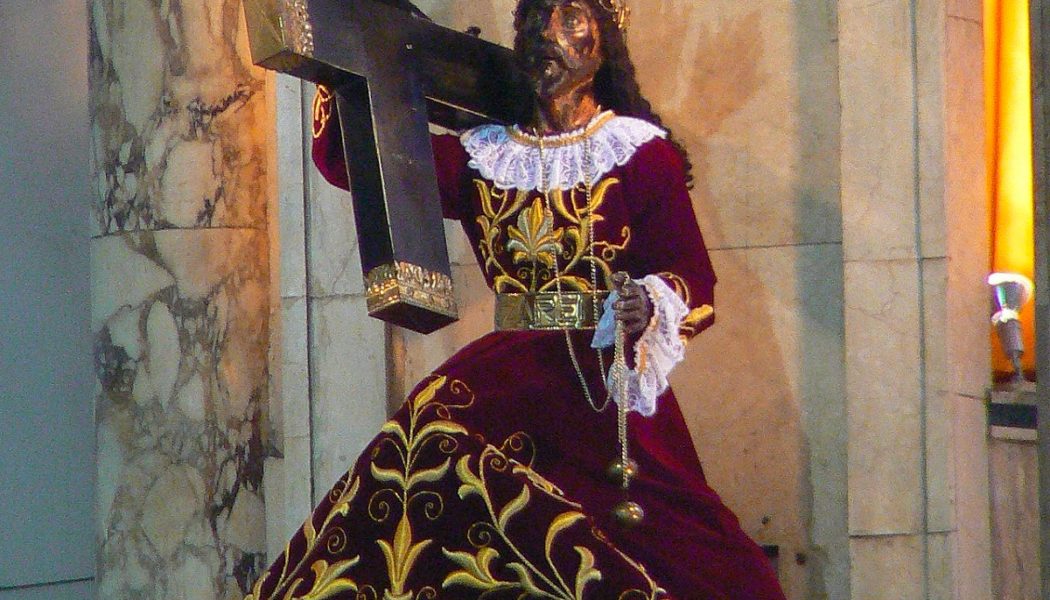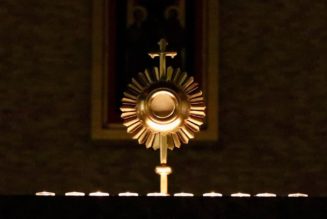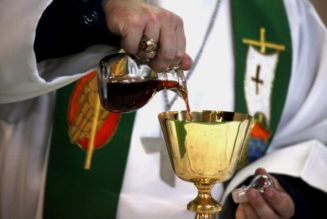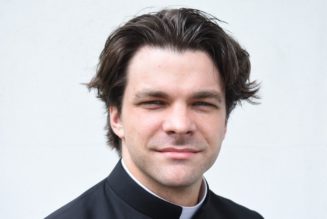Hey everybody,
Today is Tuesday of the First Week in Ordinary Time, and you’re reading The Tuesday Pillar Post.
For a lot of us, today probably feels like a return to the ordinary, with the conclusion of the Christmas liturgical season on Monday, the feast of the Baptism of the Lord.
Well, in the U.S. and other Western countries, today might feel like a normal day — but if you’re a Catholic in the Philippines, things are a little bit different.
See, every year on Jan. 9, millions of Filipino Catholics travel to Manila, to celebrate a sacred image, Nuestro Padre Señor Jesus de Nazareno.
The image — colloquially called the Black Nazarene — is a statue of Christ in agony, bearing the weight of a dark-colored cross.
It was carved in Mexico in the 1500s, and brought to the Philippines in 1606 by Augustinian Recollect missionary priests.
The statue had two different church homes in its early years, and was on Jan. 9, 1787, donated to the St. John the Baptist Church in the Quiapo district of Manila — known locally as the Quiapo Church.
The life-sized statue was carried to the Quiapo Church — and in the years after, commemorating that journey became an important Catholic piety in the Philippines, which has continued, year after year, until today.
Every Jan. 9, early in the morning — with hundreds of thousands of Filipinos lining the streets — the image begins traveling through the city, led by special ushers and traveling on a special carriage, while thousands of pilgrims walk barefoot through the streets along with it, in a walk of penitential pilgrimage. The statue’s journey through the city is usually only a few miles, but the pilgrimage takes all day, and is flanked by Masses at the Quiapo Church.
This year, 2024, is a special pilgrimage year in Manila, because the pandemic canceled the procession from 2021 to 2023. Organizers took the break to make some improvements — this year the statue will be encased in shatterproof glass, which means that pilgrims won’t be able to leap onto the carriage to kiss the statue, as they’ve customarily done.
Jan. 9 is a holiday in Manila, and a day of importance for the entire country.
In many ways, the statue itself celebrates the coming of Christ to the Philippines — the Gospel came to the Philippines in the 16th century, decades before the statue itself arrived with missionaries. And the statue has gradually become the country’s own — it was originally carved in Mexico, but the version that made its way to the Quiapo Church was a copy, carved by the Augustinian Recollects. In the 1990s, the head of the image was shot by a fanatical sect member during the procession, and damage was sustained on the Lord’s left cheek.
The damage remains — the face was not restored — but the Archdiocese of Manila did commission a sculptor to make a replica of the entire statue. Today, the statue which processes through the city is a mash-up: the damaged 1787 head, atop the 1990s body.
There are more than 90 million Catholics in the Philippines today. There are also millions of Filpinos in diaspora, in almost every corner of the world. At the synod on synodality, Manila’s Cardinal Jose Advincula said that those Filipinos, whose ancestors received the faith from missionaries, are now called to be missionaries to the world — to spread the Gospel in the places around the globe in which they live.
As they honor the Lord on Jan. 9, pray for them, for their Church, and for their call, to be missionaries of Christ, the Nazarene.
The news
The archdiocese said that a Vos estis investigation has surfaced unspecified “imprudent” actions by the archbishop, which merit the restrictions.
To Nienstedt, the Vatican’s conclusion doesn’t quite add up. We reported in a second story Friday that the archbishop has asked the Vatican to clarify what those imprudent actions actually were — apparently, Nienstedt himself is not privy to the report’s conclusion.
While the archbishop expressed regret “for any pain experienced by anyone because of the allegations against me,” he also said the Vatican should be more forthcoming about its findings.
You can read about that here. And you can expect further analysis from me a bit later this week, I expect.
—
About 20,000 Catholics met in St. Louis last week for SEEK 2024, a mega-conference sponsored by FOCUS, the international campus ministry apostolate.
Among those Catholics was Jack Figge, himself a student on a FOCUS campus, who served as our on-the-ground correspondent for the event. While he was there, Jack spoke with a lot of Catholics.
He talked with some about living the faith in a divided Church.
And while FOCUS primarily works with college students, Jack talked with some older SEEK attendees about why they come, and what the conference could mean for evangelization at their parishes.
Later this week, we’ll bring you one final report from Jack, about what happens after SEEK — and whether the post-conference glow has lasting spiritual impact. Read these, and keep your eye out for that.
Fifty-three members of the Syro-Malabar Church’s Synod of Bishops — the Eastern Church’s authoritative governing body — will vote during a meeting held over the next few days, for the next major archbishop of the sui iuris Church.
Wondering who the likely candidates are? Me too. Fortunately, Luke Coppen breaks down the front-runners for you — and explains why all of this should merit your attention.
In an analysis Monday, The Pillar’s Ed Condon argues that the arrest might mask for western readers a bigger problem — that in recent weeks, the Chinese Patriotic Catholic Association has moved to downgrade an entire diocese to the status of a parish, and without Vatican approval.
That’s a big deal, of course. And to many China-watchers, it highlights the apparent failure of Rome’s agreement with the Beijing government, which aimed to normalize the status of the Catholic Church in China.
—
And here’s some cool news.
More than 446,000 pilgrims walked the Camino in 2023, marking a trend of the pilgrim way’s continuing popularity.
‘Mystical Passion’
Of course, the news most discussed yesterday among many Catholics was the emergence of “Mystical Passion,” a book published in 1998 by now-Cardinal Víctor Manuel Fernández, who is prefect of the Dicastery for the Doctrine of the Faith.
The book has garnered attention because it includes graphic descriptions of sex and sexual acts, along with a spiritualization of sexuality, and sexualization of spirituality.
The work depicts an account of an apparently erotic encounter with Jesus, which Fernández depicts as a story recounted to him by a 16-year-old girl, who apparently experienced it in prayer.
It also makes an argument that a person can commit grave sexual sins, “without being guilty and without losing the grace of God” — an argument which tries to ground itself in the Church’s moral theology regarding subjective culpability and human agency, but which has been a focus for some criticism since the book emerged.
Since a fracas began to unfold, Fernández has told at least two media outlets that after he published the book, he would not allow it to be reprinted, because he thought that he could be misunderstood. He said that he would “not write now” the contents of the book, and that he would prefer it not be disseminated.
The Pillar has requested an interview with the cardinal, who has not yet responded to questions sent by email. Before offering more exhaustive coverage, we’ll wait on that.
But I would offer three observations:
First, I have spent the last five years of my professional life covering extensively the way in which priests have groomed and manipulated spiritual directees and other adults and minors under their pastoral care. Actually, I spent much of my career in diocesan administration learning a great deal about the same.
And I’ve learned that the sexualization of spirituality is a common theme among such clerics — that the kind of abuse cases which find their way to the DDF are rife with manipulation and spiritual grooming, which often entails pushing boundaries by encouraging a kind of intermingling of sexuality and spiritual experience.
When assessing the propriety of a situation, the sexualization of spirituality is a red flag worth noting.
Now, there is no evidence that Cardinal Fernández has ever acted inappropriately in his priesthood, and no reason to conclude that he has. But if the “Mystical Passion” text raises a question about his aptitude for the office he possesses, it’s this: Would a person who has written such a text actually see red flags pertaining to sexualization of spirituality?
Given the portfolio of the DDF, is that a potential blindspot which should give victims and their advocates cause for concern?
Now, it is worth noting that Fernandez has already recused himself from handling sexual abuse cases, which is a big part of the DDF’s mandate in the life of the Church. In that sense, the existence of the text is no more worrying for Fernández than it would be for any other curial cardinal close to the Holy Father, as one friend observed to me yesterday.
But that reality points to a deeper challenge for the Holy See: While the Church is undergoing a global reckoning on sexual abuse, the head of the most relevant dicastery on that front is sitting on the sideline, and now with questions raised about the appropriateness of his own writing.
However it’s handled, I suspect that question will linger over the Fernández administration of the Dicastery for the Doctrine of the Faith.
Second, a more interesting question is how Fernández’s work fits into the mystical and theological tradition of the spiritualization of sexuality.
There is in the Church a theological tradition that draws parallels between spirituality and the sexual act, and a mystical tradition that draws beautiful and meaningful parallels between sexuality and the spiritual life.
Think about St. Bernard, St. Teresa, and the theology of the body catechesis of John Paul II. Those kinds of reflections can be beautiful, mysterious, profound, and confounding.
But like all things sexual, they are also minefields — in this case, theological minefields, in which arguments can go wrong, and posit harmful falsehoods, quickly.
Now, Fernández has distanced himself from his own book of such reflections, suggesting he wouldn’t write something like that today, and indicating that he tried to get it pulled off the shelf.
But it will be the work of theologians to unpack whether themes in the text carry through Fernández’s work, and whether those themes offer insights into his theological mind.
And given that the other big part of the DDF prefect’s job is assessing the work of theologians, it seems clear that analyses of this book will aim to ask whether Fernández can see the “red flags” in that kind of theological work.
Third, despite “rumors” to the contrary, I think it would be naive to expect that Cardinal Fernández will resign over this brouhaha, or over other recent controversies under his tenure.
In truth, I don’t even think there really are “Vatican rumors” that Fernández will resign, as some news outlets have suggested. I think that whole idea is a fabrication, a bit of wishful thinking by his critics. I don’t expect the cardinal will do any such thing.
But the short Fernández tenure in the DDF has thus far been rife with “misunderstandings,” as the cardinal has put it, especially as this incident comes shortly after the cardinal was forced to issue a 2,000-word press release “clarifying” Fiducia supplicans, the Dec. 18 declaration on same-sex blessings.
It seems clear that Fernández has had a rough month. His critics argue that the cardinal has failed to appreciate the difficulty of the office he possesses, and has been unprepared to deal with the controversy he’s generated.
At this writing, Fernández is at something of a juncture. He’ll either say “damn the torpedoes,” and continue as if his dicastery isn’t facing new crises each week, or the challenges of the last month will impact his leadership approach and style, or the pace with which he addresses matters of global importance.
But time will tell. And if the cardinal is open to an interview with The Pillar, we’ll aim to ask him what we can.
A grown-up marriage
In the meantime, I want to thank readers of The Pillar for reaching out to me over the last week. A few days after Christmas, I got Covid, and I’m still pretty sick, believe it or not. But things are beginning to improve, and I’m aiming to be at full speed, work-wise, by the end of the week — I have some really important projects underway which have been slowed down by my being ill, and I’m just not OK with that. And there are a number of things happening in the Church that I’d like to write about, and I’ve just not been able to.
Being sick, in short, is the pits.
Mrs. Flynn also has Covid, and has also gotten hit hard with it. Many of you have written to offer prayers, and several of you priests have written to me in the past few days to say that you’ve remembered our family at the altar, offering Mass for us. Thank you. All of that means a lot.
Amid our convalescence, Mrs. Flynn and I celebrated our 18th wedding anniversary on Sunday. Our marriage, having turned 18 years old, is a grown-up now: it can buy cigarettes, join the Space Force, and spend a pretty good weekend in Vegas, if it wants.
Since we’re both sick, I wasn’t able to whisk Mrs. Flynn away for an anniversary weekend or anything like that.
Plus, I started a new journalism project three years ago — with her support — and we’re not quite into the “disposable income” phase of that project yet.
So we celebrated pretty low key, by teaching our kids how to play Tetris and Super Mario 3 on our seldom-used NES clone, and then watching with them an extremely stupid Disney Peter Pan sequel called “Return to Neverland.”
If you haven’t seen it, skip it.
I guess, in a certain way, it was the perfect anniversary celebration: We spent it with the kids God has surprised us with, all fairly sick and all in our pajamas, blessed by the gift of being together, and finding good humor in an imperfect situation. It felt a lot like our family’s vocation.
In truth, I am very lucky to be married. And I mean that practically. I reminded Mrs. Flynn on our anniversary that it’s a wonder she consented to marry me at all.
For our nuptials, I insisted on renting a somewhat silly tuxedo, which I believed at the time looked distinguished.
The night before our wedding, after adoration and the rehearsal dinner, I lost the rings. While we were looking for them, we were locked out of Kate’s family home for an hour or so, quite by accident, but without jackets in a Chicago January. And then when we finally got inside, and we resumed hunting for the rings, Kate’s finger was somehow slammed in a door — neither of us can remember quite how it happened — and turned a lovely shade of purple.
The rings were recovered only at the 11th hour.
And then on the day of our wedding, just an hour or two before the Mass started, the zipper fell off my ridiculous rented tuxedo pants — the whole zipper apparatus just fell right off, the stitches had apparently come loose, or something.
My dad had to borrow a stapler from the reception hall and staple my pants shut. That meant my beautiful bride had to marry me as I stood in her parish church wearing very silly pants, held together with a row of staples.
The staples also meant that I couldn’t take a bathroom break during the reception, but no one seemed too sympathetic on my behalf, for what it’s worth.
It was a comedy of errors. We laughed about it then, and we can laugh about it now. And we reflected that, actually, nothing in our marriage has quite gone according to plan — we don’t have as many children as we thought we’d have, we don’t have the careers we thought we’d have, we don’t live deep in the country on some ranch, like we thought we might.
But everything has been better than our plan, we’ve concluded, because it’s gone according to the superior and divine logic of Providence. We couldn’t have envisioned the path the Lord had for us, and we’re much the better for accepting the plan as he revealed it.
The key has been good friendship, good humor, strong whiskey, mutual forgiveness, and hope in the enduring promise of God. On the day we married, we promised to pursue holiness together. Of course, we were 23, we had no idea what that would entail — that the pursuit would be a lot messier, and more demanding, than we could have expected.
But I’m blessed because my wife hasn’t given up on the idea that a faithful and loving marriage can make us saints — and she hasn’t given up on me.
Nowadays, though, she’d make me get a better tux. And she’d be right.
Whatever your vocation, please be assured of our prayers for God’s presence in it. And please pray for us — we need it.
Thanks again for the well-wishes. I’m making my way back — I promise.
Sincerely yours in Christ,
JD Flynn
editor-in-chief
The Pillar
Comments 30
Services Marketplace – Listings, Bookings & Reviews












